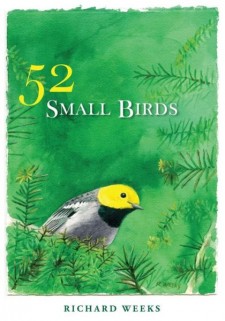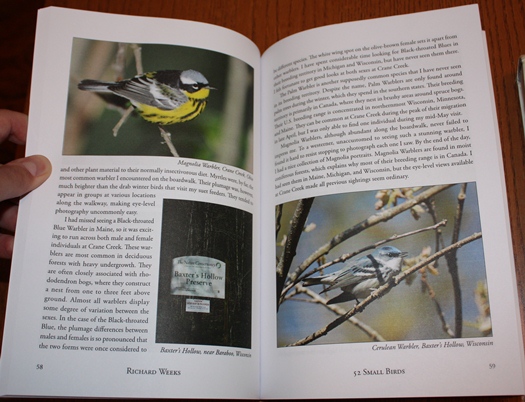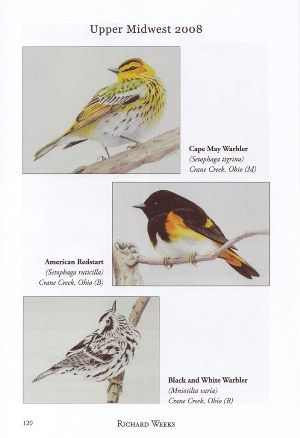Reviewed by Grant McCreary on August 29th, 2014.
What is it about warblers that they inspire an almost cult-like following among birdwatchers? If you’ve seen even just a few warblers, you already know the answer to that. It’s been said that one of the reasons we like to watch birds is because they’re so intensely alive. Nowhere does that spark of life burn brighter than in warblers. It’s no wonder that Richard Weeks, after developing an interest in birds, gravitated toward warblers. It’s not even that surprising that the pull was so strong he felt compelled to photograph and paint all of the warblers that regularly breed in the United States – a compulsion he writes about in 52 Small Birds.
Weeks is a relatively new birder, having started in his 60’s (although a naturalist for far longer). He found that he especially enjoyed photographing birds. Of course, it didn’t take him long to discover warblers. It didn’t happen at first, but his interest in warblers gradually increased until it became his goal to photograph all 52 breeding species in the U.S. (including Olive Warbler and Yellow-breasted Chat, no longer considered by taxonomists to be in the warbler family, as well as both forms of Yellow-rumped Warbler). Also an artist, Weeks used his photos as reference material to paint all the birds as well. It took him eight years to reach his goal, during which time he took 11 trips to eight states.
52 Small Birds presents the photos, the paintings, and the story. Arranged chronologically by his trips, it walks you through the process, from Weeks’ beginnings as a birder to that last warbler photo. Although somewhat limited geographically – he spent most of his time in Maine, Texas, Arizona, the upper Midwest (Ohio, Michigan, and Wisconsin), and his home state of Oregon – the reader gets a nice taste of what birding, or at least warbler-watching, is like there. All of the experiences, from unexpected successes to painful misses, make for a good story.
But the author wants to impart more than just a narrative of his warbler-photographing escapades. The theme that runs through the book is that his “search for warblers provided the impetus to experience places that would have otherwise remained unseen.” He found that experiencing all those places was just as much a reward as the photographs taken, if not more so. I can really connect with that. Like Weeks, birding has taken me many places I never would have been to otherwise, and this has become one of my favorite things about the hobby.
Weeks also has an explicit goal of encouraging people to pursue “birding as an enriching lifetime pursuit and encourage readers to become part of a collective voice advocating for the preservation of wildlife and its habitat.” He promotes this by showing one avenue of engagement with birds and their habitat. But he’s quick to point out that there are many paths other than photography. You don’t even have to be serious lister. As he writes, “the number of birds seen was not necessarily related to the degree of satisfaction derived from the travel experience.” I, myself, have a hard time feeling that way sometimes, but his relaxed approach is a nice change of pace and much more relatable for beginning birders.
52 Small Birds is a quick read. I found it interesting and Weeks has an easy, fluid style that made me want to keep reading. But it’s also pretty short; the narrative itself is only 110 pages. I think it would have benefited from some more, as there were some things that I felt were missing. Some of the warblers were mentioned and passed by quickly, without much mention of what makes them unique. The distinctive Yellow-breasted Chat, for example, gets just a single paragraph. Its “unwarblerlike” song is briefly mentioned, but not anything about its display flight or vexed taxonomy. The fact that it’s actually not a warbler (by current thinking) would have made for a good discussion. I would also appreciate more about the travel. Weeks describes how he was made to feel at home by everyone in Mio, Michigan (the place to go for Kirtland’s Warblers), and I would love more details like this.
The photographs and paintings that accompany the text are very nice. Warblers are extremely difficult to photograph well, as Weeks describes, but he did a remarkable job in getting all these pictures. A few are more like documentary shots, but they’re far outnumbered by the beautiful and interesting ones. As a bonus, the author includes 52 paintings that he produced based on his experiences and photos. These are grouped together in the back, also in chronological order.The only possible error I noticed was a photo of a purported Tennessee Warbler on page 26 that looks to me like a Philadelphia Vireo. But those species are very similar, so I’d give a pass for that (also allowing that I could be wrong). More serious is the lack of an index. Since the narrative and photos are presented chronologically, without an index the only way to look for a specific bird or place is to flip through the pages. Also, I found the printing quality to be a little disappointing. It seems like some of the photos weren’t done justice in the reproduction. Don’t get me wrong, it looks acceptable, but not up to the standards of a big-name press.
Weeks isn’t the first to pursue this quest, or even the first to write a book about it. Vera and Bob Thornton tell a similar story in their 1999 book, Chasing Warblers. I read that book long ago (about a decade – wow!), before I had seen many of the warblers. I loved it; it really stoked my desire for seeing these birds. Because it has been so long since I’ve read it, I can’t fairly compare it against 52 Small Birds. Plus, my experience reading this newer book is entirely different now that I’ve seen most of these warblers. You can’t go wrong with either, although if you’re primarily interested in warbler photos I’d suggest Chasing Warblers, as it has more bird photos and the reproduction is better.
Recommendation
As an unabashed fan of warblers, I enjoyed 52 Small Birds. It does them justice, with photos and paintings that are nice to look at and, especially, with an entertaining narrative of the author’s experiences with them. If you haven’t seen many of these birds, this book would be a good introduction. If you have, it’s a nice way to be reacquainted with some birds and places that you may not have seen for a while. And, even more importantly, it serves as a reminder of the joy in experiencing “wild things in wild places.”
Disclosure: I get a small commission for purchases made through links in this post.
Buy from NHBS
(based in the U.K.)
Disclosure: The item reviewed here was a complementary review copy provided by the author. But the opinion expressed here is my own, it has not been influenced in any way.








Comment